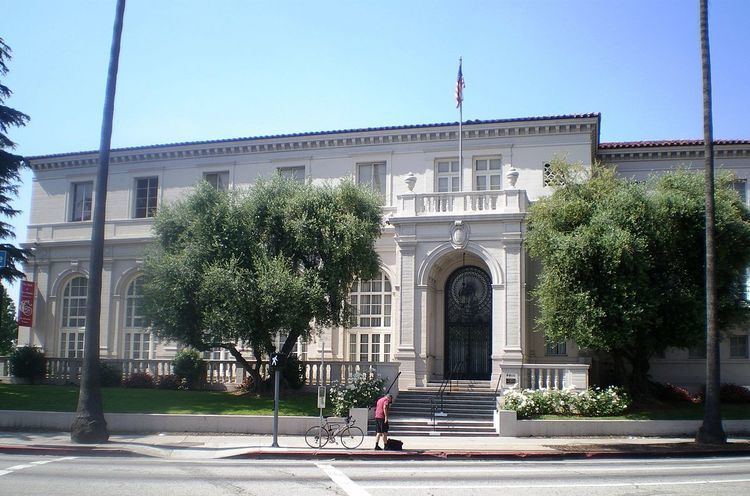Built 1927 LAHCM # 250 Opened 1927 Phone +1 323-931-1277 Added to NRHP 6 May 1994 | NRHP Reference # 94000401 Designated LAHCM 1982-08-25 Area 5,261 m² Architectural style Renaissance architecture | |
 | ||
Address 741 S Lucerne Blvd, Los Angeles, CA 90005, USA Similar Wilshire Ebell Theatre, John C Fremont Branch Li, Temple Israel of Hollywood, Cathedral of Saint Vibiana, Wilshire Boulevard Profiles | ||
In love at the ebell of los angeles
The Ebell of Los Angeles is a women's club housed in a complex in the Mid-City section of Wilshire, Los Angeles, California. It includes a clubhouse building and the renowned 1,270-seat Wilshire Ebell Theatre.
Contents
- In love at the ebell of los angeles
- The ebell of los angeles
- Formation and early years
- New building on Wilshire Boulevard
- Notable performances
- Renovation and historic designation
- References
The complex has been owned and operated since 1927 by the Ebell of Los Angeles women's club, which was formed in Los Angeles in 1894 or 1897. Since 1927, the Wilshire Ebell Theatre has hosted musical performances and lectures by world leaders and top artists. Among other events, the Ebell was the site of aviator Amelia Earhart's last public appearance before attempting the 1937 around-the-world flight during which she disappeared. It is also the place where Judy Garland was discovered while performing as Baby Frances Gumm in the 1930s.
The ebell of los angeles
Formation and early years
Ebell of Los Angeles was formed as a women's club in 1894, based on the principles and teachings of Adrian Ebell, a pioneer in women's education and organizing women's societies in the late 19th century. Harriet Williams Russell Strong was a founder of the club, serving as its president for three consecutive terms. The minutes of the first meeting of Ebell of Los Angeles identify its purpose "to interest women in the study of all branches of literature, art and science and the advancement of women in every branch of culture." The club adopted as its motto, "I will find a way or make one -- I serve."
Over the years, the group has conducted classes, and hosted lectures and seminars, on topics including psychology, parliamentary law, travel, literature, music, gardening and science. Even before moving to its current quarters, it actively promoted the arts, as when from May 23 to July 25, 1919 it sponsored a marathon ten-week series of chamber music recitals by the Zoellner Quartet.
New building on Wilshire Boulevard
In 1923, the group announced plans to build a new clubhouse and theater west of downtown on Wilshire Boulevard. Before construction began, the lot at Wilshire Boulevard and Shatto Place had appreciated in value and was sold for a profit; a new lot at the corner of Wilshire Boulevard and Lucerne was purchased in 1925.
The group commissioned architect Sumner P. Hunt of Hunt & Burns to design the new facility, which was designed in an Italian style with plaster facing and Italian clay tile roofing. The new facilities consisted of multiple structures covering a site 160 × 450 feet, surrounding a 65 × 120 foot patio area. The new facilities included a new 1,300-seat auditorium at the rear of the property facing 8th Street. The two-story structure facing Wilshire Boulevard houses the group's clubhouse, including a large lounge, art salon, and dining room. The dining room opens to a tile-roofed colonnade walkway and fountain.
The clubhouse opened with a musicale tea in October 1927, and the Wilshire Ebell Theater, originally known as the Windsor Square Playhouse, opened to the public in December 1927 with the west coast premiere of Sigmund Romberg's musical The Desert Song. When the buildings opened, the group's president wrote in the club's newsletter:
"The result of their tireless and unceasing labor may be seen at 4400 Wilshire Boulevard where a stately group of buildings now adorns a sightly eminence. The separated units have been so carefully designed as to form a magnificent mass, a colossal edifice, severely simple, classically correct, pleasing in its very ruggedness, elegant in its ornate adornment, suited to the purpose for which it was built."
The total cost was $200,000 for the site, $650,000 for the entire structure, and $120,000 for the furnishings. Another writer observed: "Nowhere in America is there a more magnificent women's club house than the new home of Ebell. ... Every modern convenience and appliance, together with furnishings of the finest quality, are within its walls. It is lavish, but not flamboyantly so. It is practical and it has beauty and inspiring charm."
The 1,300-seat theater is known for its acoustics and its Barton pipe organ. The Los Angeles Times in 2003 described the theater as "the grande dame of genteel grace," "a cultural centerpiece for Los Angeles," and "one of the area's most striking" auditoriums.
Notable performances
In more than eighty years of productions, the Wilshire Ebell has witnessed performances by many stars and celebrities, but some stand out from the rest.
Renovation and historic designation
A major restoration of the Ebell complex commenced in 1989. The theater's seats were recovered, the stage refitted, and new sound and lighting systems installed. Renovation work also extended to the main dining room (also known as the Concert Hall), the Grand Salon/Lounge, the Galleria, and the Art Salon.
In recent years, the events held at the Wilshire Ebell Theater have reflected the ethnic diversity of the neighborhood, with shows staged in Persian, Korean, and Russian. It has also been the site of annual "Divas Simply Singing" benefits for AIDS, featuring singers Nancy Wilson, Roberta Flack, Rita Moreno, and Toni Tennille.
The building has been designated as a historic structure at the local, state and national levels, including the following recognition:
